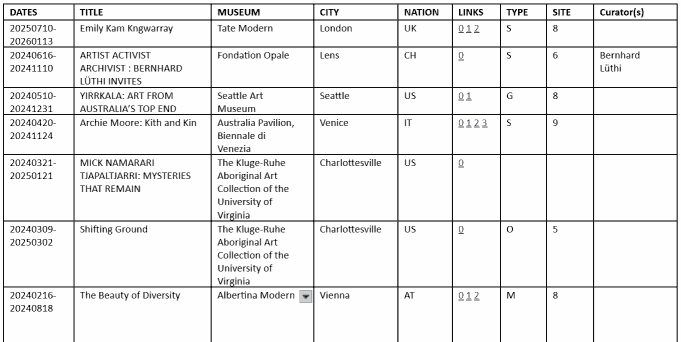300+ Art Exhibitions outside Australia
Contemporary Indigenous Australian art has been exhibited in modern art museums in very many countries during the last century, often with some financial support from government organisations to counter-balance the huge costs of transport and insurance. Verifying the titles, timing and location of some of the earlier exhibitions is difficult and even some from the last decades have not been well documented, despite the internet and archives such as www.archive.org [1] or the French/Australian private organisation IDAIA [2]. Therefore, please contact us if you have evidence of public art exhibitions beyond those listed here. Commercial exhibitions are not shown, although they can have a huge impact on the reputation of artists. [3] [4]
Table of Contemporary Indigenous Australian Art exhibitions outside Autralia
For the convenience of scholars and for ease of updating, the main table of exhibition information is available for download as a GoogleDoc page here. When using or citing the results privately or for scholarly work, please provide credit to (C) 2024 L. Frost, www.aboriginal-art.de
The top of the table is shown below (as of July 2024), showing the headings DATES, TITLE, MUSEUM, CITY and NATION. Additionally, there is a column for any internet links referencing the exhibition (the link labelled '0' is always directly from the museum) and an approximate classification of the TYPE and SITE using the following scheme:
SITE: 9= documenta or biennale ; 8= major art museum; 7= mid-level or city museum; 6= private museum or foundation; 5= University; 4= global commercial gallery; 3c= small city art museum; 3b= art association; 3a = corporate/private art space;
2= Embassy; 1= ethnographic museum;
TYPE: S= solo exhibition; G= group exhibition of a few artists; O= overview exhibition of many Indigenous artists; B= balanced mix of Indigenous with other art; M= minor participation but equal treatment
Art institutions or users are kindly asked to contact us if you detect significant misrepresentation in the approximate categories. Each exhibition is unique.
Recently a column has been added to honour the name of the curator(s) responsible for the exhibition, but this has not yet been retrospectively inserted. The profession of curator is in the decades-long process of being professionalised and made distinct from that of the director of an art museum, as is evidenced by the increasing numbers of freelance curators.
The use of numeric labels for the type of museum is for convenience in analysis.
This website will be extended in the near future with an analysis of the geographic distribution of exhibitions, and their timeline. In particular, it is already obvious from scanning the table that in any particular country (e.g. Germany or France) there were more ethnographic museum exhibitions in earlier times, and the type of exhibitions in earlier decades were of Type O or G, now trending towards B or even S.
References and External Information Sources
[1] www.archive.org is a crowd-funded organisation, like wikipedia, that accepts proposals of links for (permanent) archiving and anso attempts to trawl the internet for new (or updated) pages.
[2] IDAIA (International Development for Australian Indigenous Art) is a French-Australian enterprise promoting and supporting contemporary Indigenous Australian art, which maintains a list of exhibitions, inside and outside Australia, back through to 2012. See www.idaia.com.au
[3] The Aboriginal Art Directory is an eclectic database (or blog) of information, event listings, commercial gallery news, advertisements, and public museum exhibition announcements. A number of European and US exhibitions are listed at news.aboriginalartdirectory.com/exhibition/europe/
[4] A 2023 blog article by the Australian art critic John McDonald provides a contemporary vignette on commercial fame:
And so, when Larry Gagosian [owner of the Gagosian art gallery, founded in Los Angeles in 1980, with showrooms in multiple buildings in New York, London, Paris, Geneva, Basel, Rome, Athens and Hongkong] decides, magnimously, to show the Aboriginal paintings collected by his old buddy, Steve Martin, it is more noteworthy than any museum exhibition. It’s an announcement that Aboriginal art may be the Next Big Thing.

